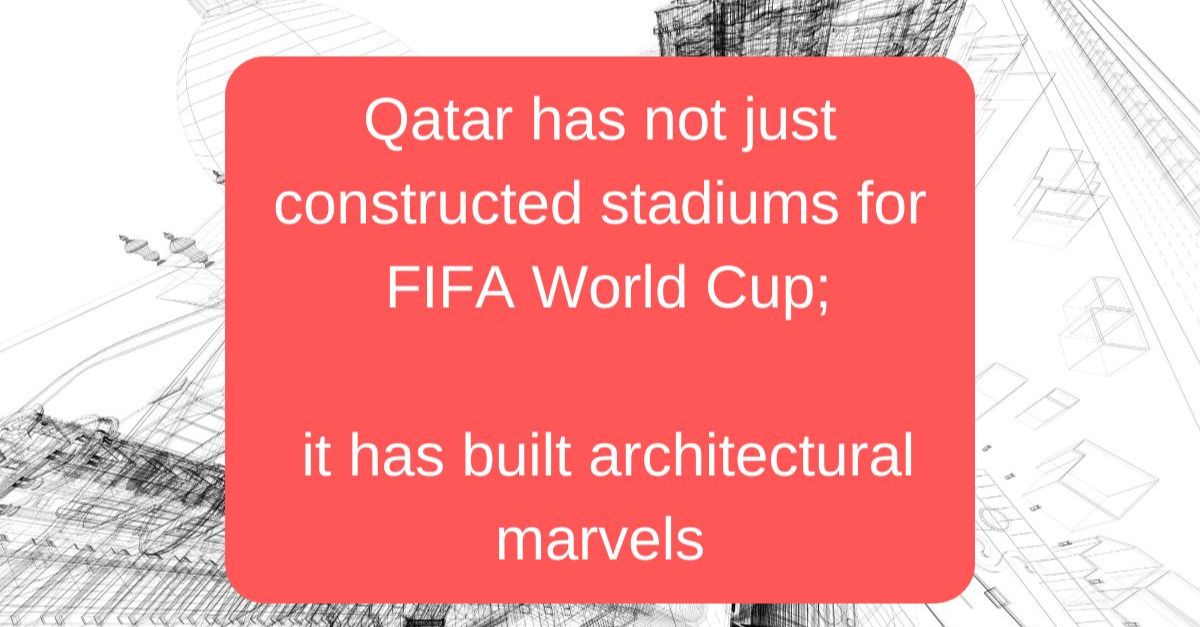Qatar has not just constructed stadiums for FIFA World Cup; it has built architectural marvels
The Qatar FIFA World Cup preparations are completed, and trial events are underway. Seemingly, the stakeholders are leaving no stones unturned in their efforts to host a memorable World Cup. Such efforts are being undertaken largely in the stadiums, where enthralling footballing action will unfold in November. Qatar went to great lengths to set up these stadiums, building seven for the event alone. Although purpose-built, these stadiums were designed with forethought, architectural ingenuity, innovation, cultural considerations, and an emphasis on sustainability.
Cutting-edge technology is the mainstay of all stadiums, embodied in the structure, as well as ancillaries such as HVAC. For example, the refurbished Khalifa International Stadium with a 40,000-seating capacity has been equipped with innovative cooling technology intended to maintain the temperature at 26 degrees Celsius — optimal for players and spectators alike. Safe to say that such an ambitious attempt to facilitate an ideal temperature is the first in the history of the FIFA World Cup. Additionally, the event experience has been made intuitive through immersive technologies and tools.
That said, the new stadiums’ inherent charm lies in their architectural excellence. The diamond-shaped stadium, which changes colour in relation to the movement of the Sun, and the Lusail Stadium, where triangular fissures leverage shade and filtered light to make it appear like a ‘Golden Vessel’, are prime examples of architectural ingenuity. Qatar’s efforts to stay true to its culture and heritage cannot be praised enough.
Rooted in culture
The Al Bayt Stadium, where the opening match will be played, has a retractable roof built like a “Bayt al Sha’ar” — a tent used by indigenous nomads. Likewise, the circular design of the Al Thumama Stadium resembles a “Gahfiya”, the traditional hat worn across the region. Lusail Stadium has murals inspired by traditional motifs. At a time when technology is increasingly rendering archaic practices obsolete, the organizers’ efforts to stay rooted in the culture are truly commendable, especially considering the speed at which the stadiums had to be developed. This also presents Qatar with an opportunity to showcase its culture and traditions to guests from across the world.
Cargotecture. Exemplified.
The most notable architectural development is Stadium 974, which is situated close to Doha port. The stadium was predominantly built using 974 shipping containers. The technique — known as “Cargotecture” — involves repurposing old cargo containers and using them in buildings. Developers have utilized 974 containers that were used to transport construction materials for stadiums — hence the name Stadium 974. Incidentally, 974 is also the international dialling code of Qatar. It has the distinction of being the first-ever demountable and reusable stadium in the world and a totem of Qatar’s rich maritime history. Most importantly, it exemplifies the promise of Cargotecture.
Aligned with sustainability
Qatar intends to fully dismantle Stadium 974 and donate the components for incorporation in sustainability projects across the world. Cargotecture is widely viewed as a viable alternative to traditional, concrete-based techniques. So, its adoption in the World Cup is indeed a strong statement. Likewise, Qatar has helmed several sustainability initiatives in these stadiums. High-performance facades, innovative cooling technologies, and the harnessing of solar power are aimed at reducing energy consumption. As a testament to the efficacy of these efforts, Stadium 974 has been awarded the five-star certification in the Global Sustainability Assessment System (GSAS). Other stadiums, too, are in line for at least four-star certification, which is a remarkable feat given the sheer magnitude and significance of these projects.




